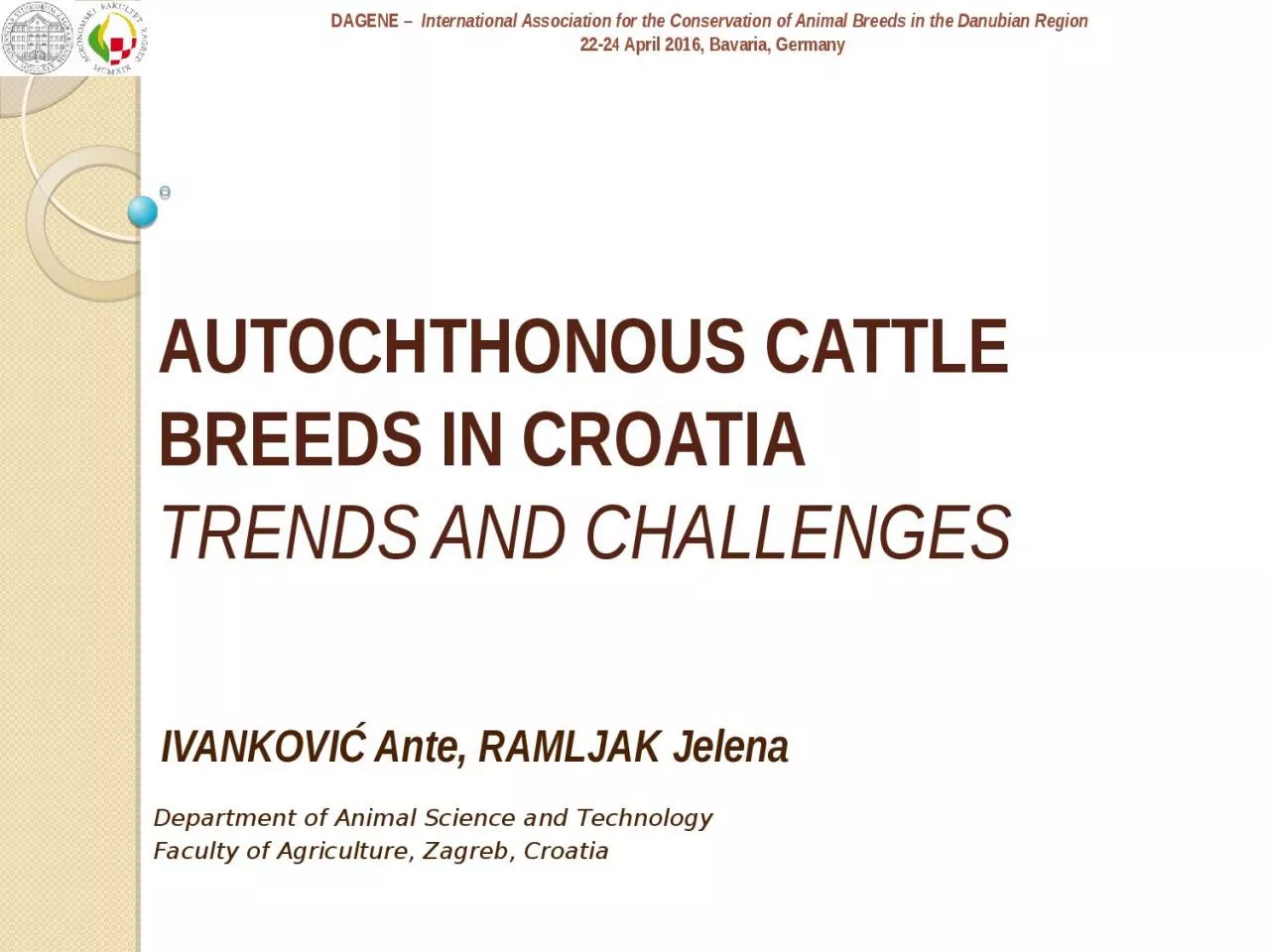

TRENDS AND CHALLENGES IVANKOVIĆ Ante RAMLJAK Jelena Department of Animal Science and T echnology Faculty of Agricultur e Zagreb Croatia DAGENE International Association ID: 928373
Download Presentation The PPT/PDF document "AUTOCHTHONOUS CATTLE BREEDS IN CROATIA" is the property of its rightful owner. Permission is granted to download and print the materials on this web site for personal, non-commercial use only, and to display it on your personal computer provided you do not modify the materials and that you retain all copyright notices contained in the materials. By downloading content from our website, you accept the terms of this agreement.
Slide1
AUTOCHTHONOUS CATTLE BREEDS IN CROATIA TRENDS AND CHALLENGES
IVANKOVIĆ Ante, RAMLJAK Jelena
Department of Animal Science and TechnologyFaculty of Agriculture, Zagreb, Croatia
DAGENE – International Association for the Conservation of Animal Breeds in the Danubian Region 22-24 April 2016, Bavaria, Germany
Slide2three Autochthonous cattle breeds
Slavonian
Syrmian Podolian cattle
BushaIstrian cattleAutochthonous cattle breeds in CROATIA
Slide3beginning of the XX >
90% of cattle population~ 1 mil cattle (1931)Istrian cattle – Istria peninsulaBusha – kars
t & mountain areaSlavonian Syrmian Podolian – Slavonia (plain and fertile land)decreasing trend (end XX):industrializationimport Simmental & crossbredsdepopulation of rural areas
BushaSlavonian Syrmian Istrian c.
Puskas, 1980
AUTOCHTHONOUS CATTLE BREEDS
-
populations
in
the
past
Slide4AUTOCHTHONOUS CATTLE BREEDS -
done till now
phenotypically characterised exterior data for each breed facilitates the implementation of breeding programsgenetically characterised
proteins polymorphism, microsatellites, mtDNA, SNPshelps to maintain genetic variability, control inbreeding levelRESULT: accomplished breeding consolidationhow can we estimate trend in population – with which indicators?is population trend is stabile, is it growing or decreasing?
Slide5to
analyse
population indicators and trendsto estimate the importance of establishing a program for economic useAIM
Slide6in general: increasing trend (breeding
♂, ♀ registered at CAA)average growth
of the population ranged from 9.4% (SSP) – 20.3% (BU)
Graph 1. Trends in number of breeding animals in period 2005 - 2014TRENDS IN POPULATIONS: 2005 – 2014
Slide72004 – Promotion and valorisation of Istrian Cattle (County support
)Busha – no such Program (promotion is more on individual level, exhibitions)
TRENDS IN POPULATIONS: 2005 – 2014
Picture 1. Example of economic utilization of native breeds through gastronomic offer
Slide8IC – oscillation (slaughtered, AI – households
with 2 to 4 cows) BU – stable trend (herd dispersion, every herd has bull, low use of AI)SSP slope – disproportion
# only one herd for a long time, monopoleGraph 2. Trends in ratio cows per bulls in period
2005 - 2014TRENDS IN POPULATIONS: 2005 – 2014↓ No ♂ 14 to 9; No ♀ only+2 ind. ↑ No ♂ 4 to 9; No ♀ only+9 ind.
Slide9female are left for breeding
# increasing trend in IC and BUgood example
(gastro offer) how economic utilization results with sustainability!Graph 3. Trends in
number of female offspring in period 2005 - 2014 TRENDS IN POPULATIONS: 2005 – 2014
Slide10Graph 4. Trends in
number of breeders
in period 2005 - 20142004 amount of subsidies decreased # interest of breeders still risesubsidies should support breeds sustainability # no situation where the whole breeding depends on subsidies
TRENDS IN POPULATIONS: 2005 – 2014
Slide11Graph 5. Trends in
number of breeding animal per breeder
in period 2005 - 2014
IC and BU have similar trend ~ 3 – 6 ind/167 & 91 breeders # SSP –15No breeders: ↑ 4 to 10; No ♀only +14 ind.No breeders: ↓ 20 to 14; No ♀only +22 ind. TRENDS IN POPULATIONS: 2005 – 2014
Slide12TRENDS IN POPULATIONS: 2005 –
2014
Ne
= 180 I – h. endangeredNe = 193 I – h. endangeredNe = 52 I – c. endangeredindicator: distribution of population; „one” area (IC) or wider (HBU)?if 75% of population are within radius of 12.5/20/50/>50 km = level of endangeraccept historical aspect / breeders don't have tendency to spread breeds on surrounding area /
step out:
export
IC to
Slovenia
(
historical
background
)
N
=10-50-100
Slide13breeding of native
breeds get more attention – all 3
breeds increased census size (9 to 20%)increased the number of breeders (1.5 to 4.0 times) increased the average size of female offspring's (~40%)balanced population structureratios of bulls vs. cows (1 bull vs.15:13:10 cows):more stabile and uniform trend (conducting breeding program, AI)
but – insufficient reproductive efficiency average number of fermale calves per breeding cow: 0.29 (IC) to 0.44 (SSP)TRENDS – current state & 2005 – 2014
Slide14sustainability and affirmation of breeds must
be in programs of economic utilization more sustainable program (e.g. Istrian cattle
) confirms the low risk level in economically inferior breeds vs. Slavonian Syrmian Podolian breeds promotionproduct with added values (handcrafts, gastro offer, dishes, …)folklores, eventseconomically vital programs can support more expensive methods of population vitalization
promotion with public media, television, …beginning: important subsidies (ggovernment) for sustainability latter: local community play important roleCHALLENGE – now & future
Slide15Thank you for attention